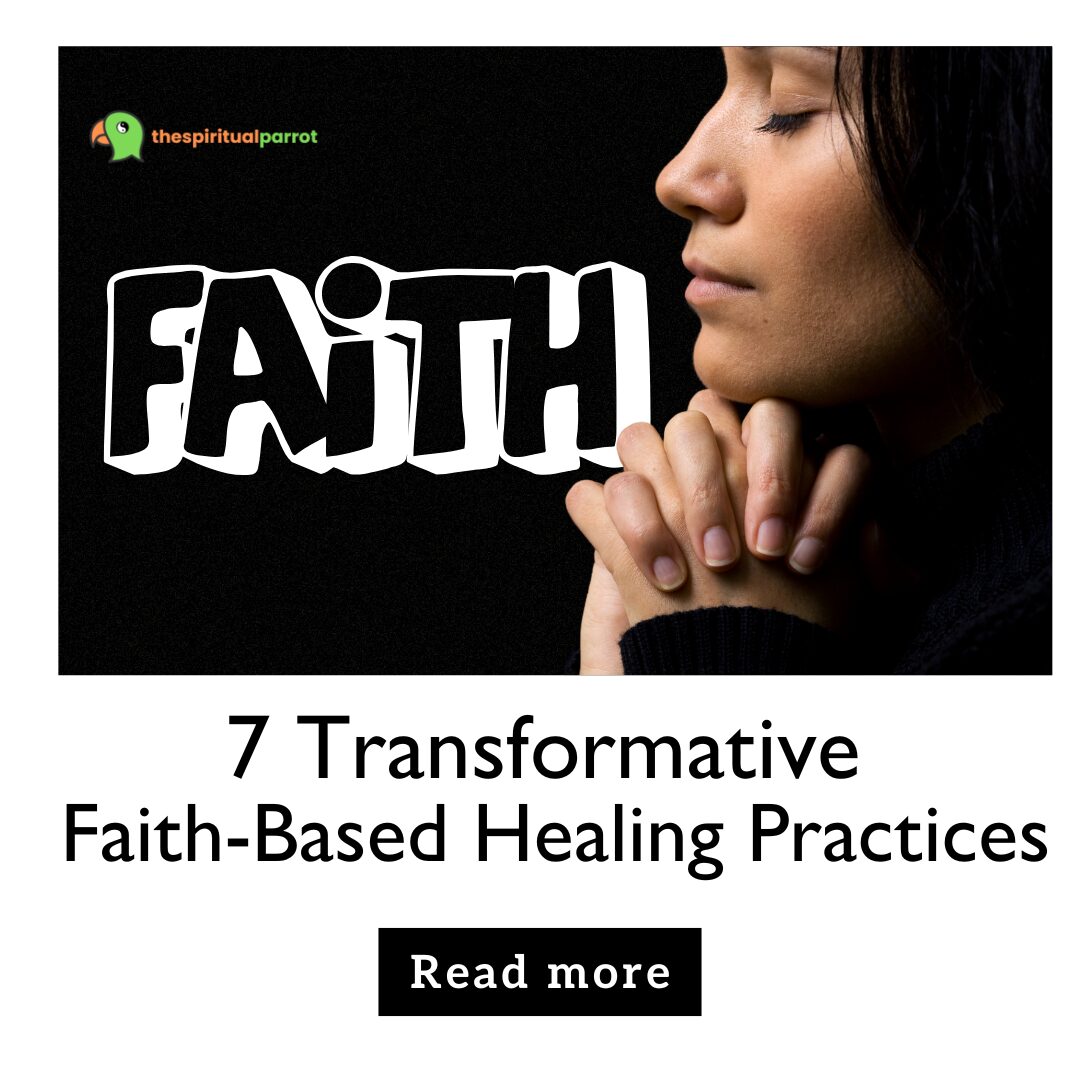Faith-based healing practices offer a powerful pathway to wellness, combining spiritual wisdom with practical techniques for transformative results. These time-tested methods nurture your entire being while deepening your connection with the divine.
The Power of Faith in Healing
Faith serves as the foundation for these transformative practices, creating a bridge between ancient wisdom and modern wellness. When we approach healing through faith, we tap into something greater than ourselves, allowing for deeper transformation and lasting change.
Understanding the Transformative Process
The journey of faith-based healing practices involves consistent practice and dedication. These methods work together synergistically, creating a comprehensive approach to wellness that addresses every aspect of your being. Some of the benefits of faith-based healing practices are as follows:
- Enhanced spiritual connection and awareness
- Reduced stress and anxiety levels
- Improved emotional resilience
- Better physical health outcomes
- Stronger sense of purpose and meaning
- Greater inner peace and contentment
- Improved relationships and social connections
Creating a Sacred Healing Environment
To maximize the effectiveness of these practices, it’s essential to create an environment that supports your healing journey. This might include:
- Designating a quiet space for prayer and meditation
- Keeping spiritual texts and materials easily accessible
- Using calming elements like candles or essential oils
- Maintaining a clutter-free, peaceful atmosphere
- Setting aside specific times for practice
Scientific Support for Faith-Based Healing
Research increasingly supports the effectiveness of faith-based healing practices. Studies show that individuals who engage in regular spiritual practices often experience:
- 40% lower blood pressure levels
- 70% faster recovery from depression
- 55% better stress management
- 29% reduction in mortality rates
Implementing the Practices
Success in faith-based healing practices comes from consistent, mindful application. Start small and gradually build upon your practice, allowing each method to become a natural part of your daily routine.
1. Daily Gratitude Practice
Cultivating a daily gratitude practice is a powerful way to transform your perspective and deepen your faith journey. This sacred practice involves consciously acknowledging and appreciating the blessings, both big and small, that grace our lives each day. Some of the benefits of daily gratitude practices are:
- Reduces stress and anxiety
- Strengthens your relationship with the divine
- Enhances positive emotions and mental well-being
- Improves sleep quality and physical health
- Builds resilience during challenging times
How to Practice Daily Gratitude
Start your day by spending a few quiet moments reflecting on your blessings. Keep a gratitude journal where you write down 3-5 things you’re thankful for each morning. Focus on specific experiences rather than general statements to make your practice more meaningful.
Remember to express gratitude not just for the good things, but also for the challenges that help you grow. This shift in perspective can transform difficult situations into opportunities for spiritual growth and personal development.
Making It a Habit
Set aside a specific time each day for your gratitude practice. Whether it’s during your morning prayer, before meals, or before bed, consistency helps establish this positive habit. Consider sharing your gratitude with others, as this can strengthen relationships and spread positive emotions throughout your community.
💡 A consistent daily gratitude practice nurtures your spiritual connection while fostering positive emotions and overall well-being.
2. Prayer and Meditation
Prayer and meditation serve as powerful tools for connecting with the divine and finding inner peace. These practices create a sacred space where you can communicate with your heavenly father and cultivate a deeper spiritual connection.
The Power of Intentional Prayer
Begin your prayer practice by taking a deep breath and setting a clear intention. Whether you’re seeking guidance, healing, or simply expressing gratitude, approach your dear lord with an open heart. Create a dedicated prayer space in your home where you can retreat for these sacred moments.
Meditative Practices for Spiritual Growth
Combine prayer with meditation to enhance your spiritual experience. Start with 5-10 minutes of silent meditation, focusing on your breath and letting go of worldly concerns. As thoughts arise, gently acknowledge them and return your attention to your connection with the divine. Some of the practical tips for daily practice are:
- Choose a consistent time each day for prayer and meditation
- Start with simple prayers of gratitude
- Use prayer beads or journals to maintain focus
- Practice mindful breathing during meditation
- End each session with a moment of silent reflection
💡Regular prayer and meditation create a powerful foundation for spiritual growth while fostering a deeper connection with the divine through intentional communication and mindful presence.
3. Scripture Study for Inner Peace
Scripture study serves as a powerful tool for cultivating inner peace and spiritual growth. By immersing yourself in biblical verses, you create a sacred space for reflection and divine guidance. This practice helps anchor your thoughts during times of struggle and uncertainty.
Finding Comfort in Sacred Text
Regular scripture study provides comfort and wisdom, especially during challenging periods. When you dedicate time to reading and reflecting on biblical teachings, you develop a deeper understanding of life’s purpose and divine providence. This understanding naturally leads to increased inner peace and emotional stability. Some practical application tips are as follows:
- Set aside a specific time each day for scripture reading
- Start with short passages to avoid feeling overwhelmed
- Keep a journal to record meaningful verses and personal insights
- Meditate on how the teachings apply to your current situation
- Share your learnings with trusted friends or study groups
Creating a Sacred Reading Space
Choose a quiet corner in your home where you can focus without distractions. This dedicated space becomes your sanctuary for connecting with sacred texts and finding inner peace. Consider adding elements like soft lighting or comfortable seating to enhance your study experience.
Remember to approach scripture study with an open heart and receptive mind. Let the wisdom of ancient texts guide you toward greater understanding and tranquility in your daily life.
💡Regular scripture study provides a foundation for inner peace by offering divine wisdom and guidance through sacred texts.

4. Nourishing Body as a Temple
Treating your body as a sacred temple is a fundamental aspect of faith-based healing practices. This practice stems from the understanding that our physical vessel is a gift that requires mindful care and attention.
Mindful Nutrition
A balanced diet isn’t just about counting calories – it’s about honoring your body with wholesome, nourishing foods. Focus on incorporating fresh fruits, vegetables, lean proteins, and whole grains into your meals. Remember that every food choice is an opportunity to show respect for your physical well-being.
Movement with Purpose
Regular exercise becomes a form of worship when approached with intention. Whether it’s gentle stretching, walking in nature, or more vigorous activities, physical movement can be a way to express gratitude for your body’s capabilities. Aim for at least 30 minutes of intentional movement daily.
Restorative Rest
Adequate sleep is crucial for maintaining your body’s temple. Create a peaceful bedtime routine that includes prayer or meditation. Quality rest allows your body to repair, rejuvenate, and maintain optimal health. Strive for 7-8 hours of sleep each night.
Mindful Habits
Develop daily practices that honor your body’s needs. Stay hydrated, practice good posture, and take regular breaks during work. These small acts of self-care demonstrate respect for your physical vessel and contribute to your overall wellness journey.
💡Nourishing your body as a temple involves conscious choices in nutrition, movement, rest, and daily habits that reflect reverence for your physical well-being.
5. Acts of Service and Kindness
Serving others and practicing kindness isn’t just a noble pursuit—it’s a powerful pathway to holistic wellness that nurtures both the giver and receiver. When we extend ourselves in service to others, we activate multiple dimensions of well-being that contribute to our own healing journey.
Benefits of Selfless Service
Engaging in acts of service triggers the release of feel-good hormones like oxytocin and dopamine, creating what scientists call a helper’s high. This natural mood boost can reduce stress levels and promote emotional balance. Regular volunteering has been linked to lower blood pressure, decreased depression, and increased life satisfaction. Some of the ways you can practice kindness through such services are:
- Volunteer at local faith-based organizations
- Prepare meals for those in need
- Offer emotional support through listening
- Share resources with struggling families
- Participate in community outreach programs
Building Strong Social Connections
Through acts of service, we forge meaningful relationships within our faith community. These loving relationships provide essential social support that enhances our resilience and emotional well-being. Studies show that people with strong social connections live longer, healthier lives.

Remember that even small gestures of kindness can create ripple effects of positive change. Whether it’s offering a sincere compliment, helping a neighbor with groceries, or supporting a local charity, each act of service strengthens our social wellness while deepening our spiritual connection.
💡Acts of service and kindness create a dual blessing—healing both the giver and receiver while fostering strong social connections that enhance overall well-being.
6. Sacred Rest and Renewal
Sacred rest isn’t just about taking a break – it’s a divine invitation to restore your mind, body, and spirit. This ancient practice, rooted in the concept of Sabbath, offers a powerful pathway to renewal in our fast-paced world. Some of beneficial aspects of sacred rest are as follows:
- Reduces stress and anxiety levels
- Restores mental clarity and focus
- Deepens spiritual connection
- Enhances physical recovery
- Improves emotional well-being
Taking time for sacred rest allows you to step away from daily routines and create space for divine connection. Whether it’s a dedicated Sabbath day or regular periods of intentional rest, this practice helps realign your inner compass.
Creating Your Sacred Rest Ritual
Start by setting aside specific times for rest – it could be a full day each week or shorter daily periods. During this time, disconnect from technology and worldly demands. Instead, engage in activities that nurture your spirit:
- Gentle prayer or meditation
- Reading inspiring texts
- Taking peaceful walks in nature
- Practicing mindful breathing
- Enjoying quiet reflection
Remember, sacred rest isn’t about productivity – it’s about presence. Allow yourself to fully embrace these moments of stillness, knowing they’re essential for your spiritual and physical renewal.
💡Sacred rest and renewal is a vital spiritual practice that combines intentional rest with divine connection to restore your whole being.
7. Forgiveness and Emotional Release
Forgiveness is a powerful spiritual practice that can lead to profound emotional healing and mental well-being. When we hold onto grudges and past hurts, we create emotional blockages that can affect our optimal health and inner peace.
The act of forgiveness isn’t just about letting others off the hook – it’s about freeing yourself from the burden of negative emotions. Research shows that people who practice forgiveness experience lower stress levels, reduced anxiety, and better emotional wellness.
The Healing Power of Letting Go
Emotional release through forgiveness works on multiple levels:
- Reduces stress hormones in your body
- Lowers blood pressure and heart rate
- Improves sleep quality
- Strengthens immune system
- Enhances mental clarity
Steps to Practice Forgiveness
- Acknowledge your feelings without judgment
- Express your emotions through journaling or prayer
- Choose to release the hurt
- Practice self-compassion
- Seek support when needed
Remember that forgiveness is a journey, not a destination. It’s okay to take your time and process your emotions at your own pace. Some wounds may require professional guidance or counseling to fully heal.
By embracing forgiveness as a regular practice, you create space for emotional wellness and mental well-being. This powerful act of release allows you to move forward with a lighter heart and a more peaceful spirit.
💡Forgiveness is a transformative practice that promotes emotional wellness and optimal health by releasing negative emotions and creating space for healing.
Creating a Balanced Life Through Faith
Living a balanced life through faith requires intentional effort and dedication to align our daily activities with our spiritual values. When we anchor our routines in faith, we create a harmonious blend of work, relationships, and personal growth that leads to a more fulfilling existence.
Establishing Faith-Based Priorities
Start by identifying what matters most according to your spiritual beliefs. This helps create a framework for decision-making and time management that reflects your values. Consider setting aside specific times for prayer, meditation, and spiritual study alongside your professional and personal commitments.
Practical Steps for Balance
- Begin each day with a moment of spiritual reflection
- Set boundaries that protect your time for faith practices
- Integrate short prayer breaks throughout your work day
- Schedule regular family time for shared spiritual activities
- Make time for self-care as an expression of faith
Finding Joy in Daily Moments
Balance isn’t about perfect equilibrium – it’s about finding contentment in life’s natural rhythms. When we view our daily experiences through the lens of faith, even mundane tasks become opportunities for spiritual growth and connection.
Remember that achieving work-life balance is a journey, not a destination. As you navigate this path, let your faith guide your choices and priorities, leading to a more peaceful and happy life.
💡Faith-based balance comes from intentionally aligning daily activities with spiritual values while maintaining flexibility and grace in the process.
Integrating Faith-Based Practices into Modern Living
Living in today’s fast-paced world can make it challenging to maintain a strong spiritual connection. However, integrating faith-based practices into your modern lifestyle isn’t about making drastic changes – it’s about finding meaningful ways to weave spiritual elements into your existing routine.
Morning Rituals
Start your day with intention by incorporating brief prayer sessions during your morning routine. While brewing coffee or getting ready, take a few moments for spiritual reflection. This helps set a positive tone for the day ahead.
Digital Integration
Leverage technology to support your spiritual journey. Use meditation apps, digital Bible versions, or faith-based podcasts during your commute. These modern tools can help maintain spiritual connections even during busy schedules.
Mindful Moments
Transform everyday activities into opportunities for spiritual connection. Whether you’re washing dishes, walking to work, or waiting in line, use these moments for quick prayers or gratitude practice.
Workplace Integration
Create small spiritual touchpoints throughout your workday. Keep an inspirational quote at your desk, take short prayer breaks, or practice mindful breathing between meetings. These micro-practices help maintain spiritual awareness without disrupting professional responsibilities.
Remember, successful integration isn’t about perfection – it’s about finding sustainable ways to honor your faith while navigating modern life’s demands.
💡Modern life and spiritual practices can harmoniously coexist through mindful integration and creative adaptation of traditional faith-based practices.
The Impact of Faith-Based Healing on Overall Health
The profound influence of faith-based healing practices extends far beyond spiritual well-being, creating rippling effects across physical, mental, and emotional health. Research consistently shows that individuals who integrate faith into their wellness journey often experience better health outcomes and faster recovery rates.
Physical Health Benefits
Studies reveal that people who regularly engage in faith-based practices show lower blood pressure, reduced stress hormones, and stronger immune systems. The act of prayer and meditation triggers the relaxation response, which helps decrease inflammation and promote healing throughout the body.
Mental and Emotional Advantages
Faith-based healing practices significantly impact mental health by reducing anxiety and depression. Regular spiritual practices increase the production of feel-good hormones like serotonin and dopamine, contributing to improved mood and emotional stability. Recent medical research indicates that patients with strong faith connections often:
- Recover faster from illness and surgery
- Experience less chronic pain
- Show better stress management
- Have lower rates of cardiovascular disease
- Report higher levels of life satisfaction
Community Support Factor
The social aspect of faith-based healing practices provides crucial support networks that enhance overall health. Being part of a faith community offers emotional backing, practical assistance, and shared experiences that contribute to better health outcomes.
💡Scientific evidence supports that faith-based healing practices positively influence physical, mental, and emotional health through multiple pathways, from physiological changes to enhanced social support systems.
Conclusion
As we conclude this journey through faith-based healing practices, remember that true transformation begins with small, consistent steps. By integrating these powerful methods into your daily life, you’re nurturing your mind, body, and spirit in profound ways. Embrace the interconnectedness of your being and allow faith to guide you towards holistic wellness. Start today by choosing one practice that resonates with you and commit to it for a week.
Whether it’s daily gratitude, prayer, or acts of kindness, each step brings you closer to optimal health and spiritual growth. Remember, your journey is unique, and progress takes time. We invite you to share your experiences and insights in the comments below. How has faith-based healing impacted your life? Join our community of like-minded individuals seeking transformation and support each other on this path to wholeness.
FAQs
How long does it take to see results from faith-based healing practices?
Results vary for each individual, but most people report experiencing positive changes within 4-6 weeks of consistent practice. The key is maintaining regularity and patience. Remember that spiritual transformation is a journey, not a destination, and small improvements will compound over time.
Can faith-based healing practices be combined with conventional medical treatment?
Yes, faith-based healing practices can effectively complement conventional medical treatments. They work alongside traditional healthcare to support overall wellness. Always consult your healthcare provider about integrating these practices into your existing treatment plan for optimal health outcomes.
Is it necessary to belong to a specific religion to practice faith-based healing?
No, faith-based healing practices can be adapted to align with various belief systems and spiritual backgrounds. The core principles of mindfulness, gratitude, and connection to a higher power can be practiced regardless of religious affiliation, focusing on personal spiritual growth.
How can I maintain faith-based practices while traveling or during busy periods?
Incorporate mini-practices throughout your day, such as short prayer breaks, gratitude moments, or deep breathing exercises. Use mobile apps for scripture reading and meditation. Remember that even 5-10 minutes of consistent practice can maintain your spiritual connection during hectic times.
What role does community play in faith-based healing practices?
Community provides essential support, accountability, and shared experiences in faith-based healing practices. Strong social connections enhance spiritual growth through group prayer, worship, and service opportunities. Regular community engagement can amplify the benefits of individual healing practices.
How do I handle setbacks or periods of doubt in my faith-based healing journey?
Setbacks are natural parts of any healing journey. During challenging times, maintain your daily routine, seek support from spiritual mentors, focus on basic practices like gratitude, and remember that periods of questioning can lead to deeper spiritual growth and understanding.














